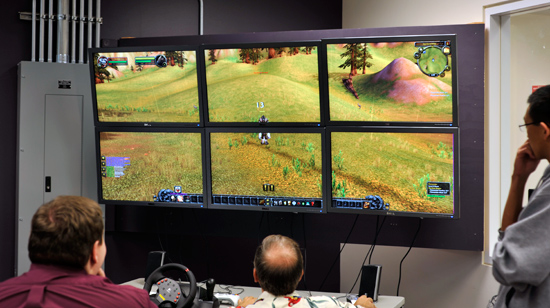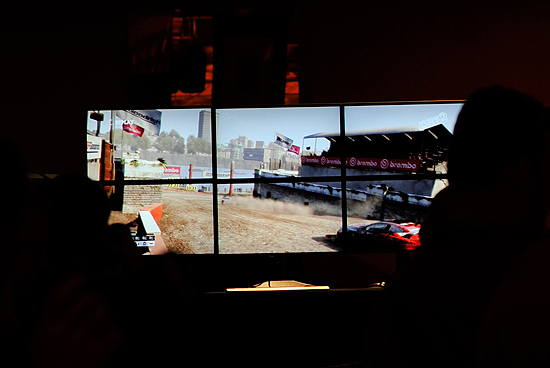Beginnings of the Holodeck: AMD's DX11 GPU, Eyefinity and 6 Display Outputs
by Anand Lal Shimpi on September 10, 2009 2:30 PM EST- Posted in
- GPUs
The First Generation Holodeck by 2016
When AMD first told me about the RV770 they told me another interesting story. For the past several years AMD (and ATI before it) has been obsessed with trying to figure out when it would be possible to render an image so convincing that it was indistinguishable (at least mostly) from reality.
Given the right art and a good technique to render the scene, this is totally possible not only within our lifetimes but within the next decade. Unfortunately, that's not enough.
Carrell estimates that the human eye can directly resolve around 7 million pixels, almost twice the resolution of a 30" display. But that's just what it's directly focusing on, all of the peripherial vision brings the total up to around 100 million pixels. The Eyefinity demo I showed earlier was running at 24.5 million pixels on a single GPU; you can estimate that at this generation we'll be able to do about 50 million pixels with two GPUs and one more generation from now we'll get to that 100 million pixel marker. That's two years for a single GPU. Then give it a few more years to be able to render that many pixels but with enough complexity to actually look real.
Rendering something at the max resolution that the human eye can resolve isn't enough however; you have to feel immersed in the graphics. That's where Eyefinity comes in, at least what it starts to come in.
Carrell believes that in seven years we can have the first generation Holodeck up and running. For those of you who aren't familiar with the Trek reference, Carrell believes it'll take seven years to be able to deliver a 180 degree hemispherical display (you're not completely surrounded by displays but at least your forward and peripheral vision is) with positionally accurate and phase accurate sound (both calculated by the GPU in real time). The GPU will also be used to recognize speech, track gestures and track eye movement/position.
It doesn't solve the issue of not being able to walk forward indefinitely, but again this is only the first generation Holodeck.
Eyefinity isn't anywhere close, but if you understand the direction: it's a start.

We're at six 2560 x 1600 displays today, is it too far fetched to imagine a totally immersive display setup that renders at life-like resolutions?
First person shooters pretty much dictate that you'll need an odd number of displays to avoid your crosshairs spanning multiple monitors. With three displays you can begin to get the immersion effect, but buy five and you'll be completely surrounded by your game. And as I mentioned before, it doesn't require any special application or OS support, the drivers take care of everything: it just appears as a single, large, surface.
It seems trivial but honestly we haven't had the ability to easily support the ridiculous display setups we always see in sci-fi movies. Eyefinity at least makes it look like we can build the PCs from the Matrix.
Will it succeed? Who knows. Does it sound gimmicky? Sure. Is it cool? Yeah, I'd say so.

If panel prices could drop significantly enough where putting together an Eyefinity display setup didn't cost more than the graphics card, I think it'd be a much easier sell. Obviously AMD's next-generation GPU is more than just Eyefinity, but you'll hear about the rest late this month.










137 Comments
View All Comments
pixel00706 - Friday, September 11, 2009 - link
Yeah But imagine 6 X cheapy data projectors....no lines massive display :). Problem is an area big enough to project it ontoGriswold - Friday, September 11, 2009 - link
Case in point, look at the WoW screen shot..screen cut right in half were character is located. lolI wonder why they didnt use pivot to circumvent that problem. Five displays in a single row instead of two and the center display will not cut the area with the character in half, while at the same time provide the desired hight at the cost of some width. That would work for me...
duploxxx - Friday, September 11, 2009 - link
perhaps have a look at Barco, also one of the preferred ATI/AMD board vendors and see what they do with screens, they already have full glued monitors where you can drive 2 gpu to 1 monitormisuspita - Friday, September 11, 2009 - link
Those monitors are not thought out for that purpose. But http://www.seamlessdisplay.com/products_radius320....">http://www.seamlessdisplay.com/products_radius320.... these are.Iketh - Friday, September 11, 2009 - link
Please read the entire article before posting. It's clearly stated that AMD already has one manufacturer lined up to make monitors with very thin bezels, and for FPSs, you would use an odd number of displays so your crosshairs are in the center of a monitor. It's all in the article.RamarC - Thursday, September 10, 2009 - link
gotta agree. nice tech demo, but wouldn't you rather have a single 60+ inch LED display?zebrax2 - Thursday, September 10, 2009 - link
How many organs do i have to sell to buy a 60+ inch led display with a resolution greater than 25+ mega pixels? Seriously though yields would be so low on those.taltamir - Thursday, September 10, 2009 - link
Building such a monitor is not difficult. Making something run on it is.
By giving us the software, the open the door for a company to design such a monitor.
erple2 - Thursday, September 10, 2009 - link
[quoting block]I've yet to see someone use a monitor setup like that for gaming. It looks terrible with the lines between monitors. Video card manufacturers have been trying that for ages now, Matrox tried and failed at it already. Let it die. AMD.[/quoting block]I think that what makes this a brilliant thing isn't that you _can_ hook up 6 monitors to a single graphics card, but that it works as if it's just one monitor. I think THAT is the innovation that ATI's done - all other implementations I've seen basically treat each monitor as a separate entity, and have to handle them within the OS separately. This treats it all as a single 7500x3200 resolution display. THAT is the cool part, I think.
I think that one of the things that Matrox did back in the day was some clever tricks to try and get the OS to recognize the displays correctly. Looking back on it, there was this concept of "primary display", "secondary display" and "tertiary display". Not "this is my display that's huge".
Perhaps it's just a "name swap", but I can see that this sort of thing is what you need for abstracting arbitrarily large displays (made of one, giant, single display or multiple smaller displays).
sparkuss - Thursday, September 10, 2009 - link
I could see it working if they just find a different mounting scheme.It seems the only obstacle is the bezels, surely there's technology for that side of the coin as well to allow the panels to butt up against each other without a bezel.
I have already seen flight sim stations that it won't be a problem for even now because the "cockpit" windows already encompass a bezel.
Course once we have flexible "affordable" OLEDs maybe even wilder setups possible.